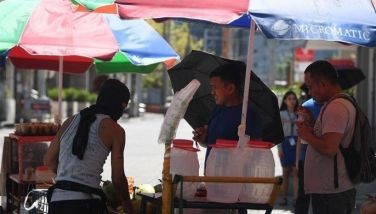PNP deplores 'digital vandalism' on Camp Crame wall

MANILA, Philippines — The Philippine National Police on Wednesday slammed what they said was a "deplorable" piece of digital "vandalism" on the walls of the PNP headquarters, saying it defaced a "historical landmark."
On Tuesday night, artist group Concerned Artists of the Philippines projected a mock 'wanted' poster showing President Rodrigo Duterte's face on the walls of Camp Crame during a protest on the anniversary of the 1986 EDSA People Power Revolution.
The group earlier said that the point of displaying the images was to "denounce the various forms of human rights abuses carried out by the Duterte administration.”
"This is part of a collective campaign of artists and cultural workers called ARTISTS FIGHT BACK, which aims to expose the government’s accountability for the successive attacks to our freedom of expression and public participation, civil and human rights, socio-economic and environmental rights, and democracy," CAP also said.
“Although the vandals did not leave any visible mark, the fact that the attack targeted a national historic site on the same day that the country commemorates the anniversary of the EDSA People Power Revolution makes it totally deplorable,”Brig. Gen. Bernard Banac, PNP spokesperson, said in a statement sent to reporters.
In February 1986, activists, nuns, and citizens formed a human barricade around Camp Crame, where Juan Ponce Enrile and Fidel Ramos took refuge after breaking with Ferdinand Marcos, who was later ousted as a dictator.
Banac said that while the national police does recognize freedom of expression, this has limits and thus should “not step beyond national interest.”
But, Bagong Alyansang Makabayan secretary general Renato Reyes wrote in a separate Facebook post: "So who defines national interest here? The corrupt implementors of 'Tokhang'? The fascist enemies of free expression?"
"Tokhang" is the signature "knock and plead" operations of the Duterte administration, where police officers visit alleged drug "personalities" at home to convince them to give up and to go through rehabilitation.
READ: There is more to graffiti than 'making a mess,' activists say
'More than just making a mess'
Graffiti also angered Manila City Mayor Isko Moreno last November, prompting him to direct the city's Department of Engineering and Public Works to paint over protest are that painted on the walls of the Lagusnilad underpass in Manila.
"Kapag nahuli ko kayo, ipadidila ko sa inyo ito,” he said then as he led the cleaning operations in the city.
"Ang ganda ganda na eh. Ang linis na. It took 15 years for that underpass to be attended. Nobody attended to that underpass."
(If I catch you, I will make you wipe that off with your tongue. It was already beautiful. It's now clean.)
In an earlier interview with Philstar.com, Donna Miranda of artists and peasant advocate group Sama-samang Artista para sa Kilusang Agraryo pointed out that even under the legal framework, there was technically no nationwide law that prohibited vandalism.
"Napakahalagang mensahe no’n (Panday Sining graffiti) para sa masang Pilipino. Sinasabi no’n protektahan ang ating soberanya. At binura ‘yun ng LGU ng Manila," she said.
“May malaking sinasabi ‘yun sa panunupil ng ating karapatan, hindi lang magpahayag pero ng ating assertion ng ating karapatan for self-determination and sovereignty.”
(The Panday Sining graffiti has an important message for the Filipino people. It says that we should defend our sovereignty. And the Manila local government unit erased that. That says a lot about how our rights are repressed, not just to freedom of expression but also our assertion of our right to self-determination and sovereignty.)
The protest slogans erased by the Manila LGU included phrases like, “Presyo, Ibaba! Sahod, Itaas!” and “US-China Layas!”
Lisa Ito, secretary general of CAP, defended the group's demonstration in a Facebook post, writing, "Camp Crame was recognized as a national historical site also because it was a space for enacting People Power and asserting democracy against a dictator."
"The light projection images are a reminder of your motto, also on the walls, to “serve and protect” the Filipino people, not rights violators and traitors like Duterte," she said.
"Why is the PNP so scared of images and words that illuminate this?" — with report from Ratziel San Juan
- Latest
- Trending































